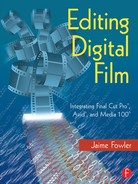0%
24Chapters
0-1Hours read
0kTotal Words
Book Description
At long last, film and video editors are using the same systems to edit their projects, and Editing Digital Film is the guide to show them how to do it. This concise reference provides video and film editors familiar with the Avid, Media 100, and Final Cut Pro systems with crucial information they will need to edit on all three of these systems. In addition to showing film editors and directors working on DV projects how to edit for this new format, this text also clarifies the NLE process to those familiar with traditional film editing.With its focus on the essentials of integrating nonlinear editing with film, Editing Digital Film is an excellent resource for video editors wishing to edit films, and for film editors wishing to learn how films are integrated into nonlinear systems. With coverage the film cutting process, post production methods, telecine, matchback editing, HDTV, 24P, cutting DV, and all necessary tools to get the job done, this is the perfect guide for those interested in editing digital film.
Table of Contents
- Cover
- Half Title
- Title Page
- Copyright
- Dedication
- Contents
- Preface
- Acknowledgements
- Chapter 1: Tools of the Film Editor
- A Tour of the Film Cutting Room
- Film Gauges and Shooting Formats
- Anamorphics
- Soft Mattes versus Hard Mattes
- Camera Rolls and Sound Rolls
- Numbering Formats
- Ink Numbers
- Key Numbers
- Time Code
- Production Notes
- Script Supervisor Daily Log
- Facing Pages
- Lined Scripts
- Camera Reports
- Sound Reports
- Code Books
- Slates
- When Good Notes Go Bad
- Chapter 2: Post Production Workflow
- Chapter 3: Telecine Demystified
- Chapter 4: Conforming a Workprint
- Chapter 5: Cut Lists
- Chapter 6: 24 fps versus Matchback
- Chapter 7: Editing Film on Avid NLEs with FilmScribe
- Converting Telecine Files
- Setting up the Project
- Adjusting Film Settings
- Importing ALE Files
- Combining Events Based on Scene Number
- Combining Events Based on Camera Roll
- Merging Events with Known Sources
- Checking Key Numbers
- One Frame Delays
- Frame Miscounts
- Mislabeled or Duplicate Numbered Tapes
- Using Autosync
- Film Effects
- Film Dissolves
- Mattes
- Blow-ups
- Script Integration
- Using FilmScribe
- Unique Items for Individual Types of Cut Lists
- Change Lists
- Preview Code
- Quicktime Options
- Exporting Audio
- Digital Cut
- OMF
- The OMF Export
- Exporting an EDL
- Saving the EDL
- Some Important Notes about Saving EDLs
- Outputting Video
- Chapter 8: Editing Film on Media 100 NLEs with Slingshot Pro
- About Media 100
- About Slingshot and Trakker Technologies
- Drag and Drop Functionality
- Supported Telecine Logs
- Import Logs
- TLC Files
- Dailies Log
- Log Conversion Procedure
- TLC Preferences
- Choosing Destinations
- Enable Tracks
- Syntax Error Correction
- Synching Picture with Sound in Media 100
- Film Trakker
- Film Trakker Preferences
- Format
- Check Syntax on All Inputs
- Flag and Match Unknown Tape Names
- Disable SyncLock
- Show EDL Comments
- Use Feet + Frames vs. Absolute Frames
- Cut List Options
- Cut List
- Dupe Lists
- Dupe List Options
- Pull List
- Pull List Options
- Optical List
- Optical List Options
- Creating the Cut Lists
- The Sound Tracer
- Sound Tracer Preferences
- Running the Lists
- Chapter 9: Editing Film on Final Cut Pro NLEs with FilmLogic
- FilmLogic
- Importing the Telecine Log
- Logging the Database Manually
- A Word about Backing Up and Undo
- Working with FilmLogic’s Database
- Linking Media to the Database
- Verification
- Info
- Conforming
- Reverse Telecine
- Limitations
- Sound Considerations
- Exporting Batch Lists
- Importing the Batch Capture Log
- Editing with Final Cut Pro
- Exporting a Cut List
- Exporting EDLs
- Future Hopes
- Chapter 10: Cutting DV for a Film Release
- Chapter 11: HDTV, 24p, and the Future
- Glossary
- Appendix A: Time/Footage Conversions
- Bibliography
- Webliography
- Index
